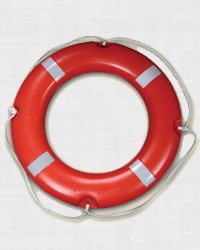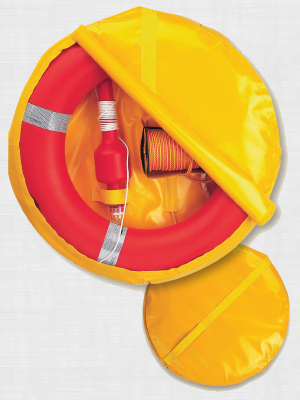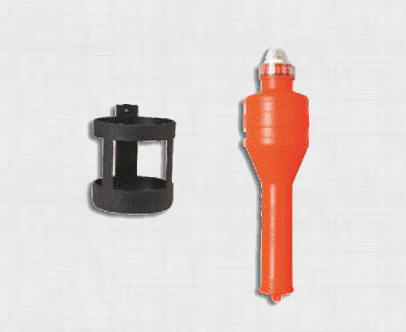Life Buoy Ring SOLAS:

The SOLAS Lifebuoy ring is designed for recreational and commercial usage. It features an orange, rack hard, cross-linked polyethylene outer shell that will not deteriorate and is unaffected by extreme weather conditions CE approved to SOLAS (L.S.A Code)* by G.L. Hamburg.

Set Lifebuoy Ring SOLAS/Lifebuoy light/30m Rope/Case:

This SOLAS Lifebuoy Ring
Set complies with SOLAS 74.96 regulation and features the
following equipment:
- 1 lifebuoy ring
- 1 floating light
- 30 m of yellow floating
retrieval line, Ø 8mm.
The whole set is
packed in a yellow coated fabric storage case which is resistant
to UV-rays. It also features clips in to be mounted on the
boat's rails.

Life Buoy Ring Light::

Lifebuoy Light M.O.B
(LSA Code)
This lifebuoy light
complies with the L.S.A code capable of burning continuously
With a luminous intensity of not less than 2cd in all directions
of the upper hemisphere for a period of at least 2h (at white
color). CE approved.
to SOLAS (L.S.A Code)*
by Bureau Veritas*.

ADVISOR - Man
Overboard devices:
The Regulations:
All lifebuoy rings intended for use in commercial ships must follow
SOLAS regulations (96/98/EC). As far as horseshoe lifebuoys and Life
links are concerned, there is no standard commonly accepted by all
countries. In this case, each country sets its own requirements for
the construction, the design and the durability of such products.
Depending on the model, Lalizas Horseshoe Lifebuoys are approved
according to Greek and French regulations. Use: The main use for
these products is the rescue of M.O.B (Man over Board). In order to
facilitate the rescue of those who have fallen over board, retro
reflective tapes and bright colors are used to increase visibility.
Instructions for use:
When someone falls overboard, a series of actions should take place
in the shortest time possible, in order to effect a rescue. If you
have a lifebuoy ring or horse shoe lifebuoy on board, you must throw
it towards the person in the sea and notify the person in charge of
the vessel. The person in the water should hold tightly and securely
on to the lifebuoy, in order to stay afloat. Please keep in mind
that the above-mentioned products are effective only when the person
is able to swim and can assist to their own recovery. Consequently,
if you have children or non swimmers on board make sure they wear
the appropriate lifejackets at all times.
PLEASE REMEMBER that
prevention is better than cure! You should ensure that you have
taken all possible actions and safety precautions, in order to
prevent someone from falling overboard. Practice the MOB procedure
during the day and night, in all weather and sea conditions,
simulating a casualty using a fender with a bucket attached.
Instruct a member of the crew to watch the person in the water and
point continuously.
- Always wear a lifejacket and harness that
is correctly clipped on when on deck, at night or in bad weather
- Make sure that you hold on to a secure part of the boat at all
times. One hand for you and one for the boat
Maintenance / Replacement:
These products are designed to withstand most weather conditions and
exposure to sun light. However, in order to keep this equipment in
good condition, contact with flame, extreme temperatures and any
sharp edges should be avoided. Lalizas suggests that you check the
products and their straps thoroughly for any sign of wear,
especially after use. If any signs of wear are detected, the items
should be replaced.
What can the casualty do?
Firstly, the casualty must remain as calm as possible and look for
the lifebuoy that may be floating close by. Taking into account that
the greatest threat to survival is cold, the casualty should cross
their legs and hold the arms tightly together to restrict any
movement and consequently the loss of heat. Also, wrist, ankle and
neck joints should be closed tightly. A light and a whistle on the
lifejacket can be used to attract attention. In most cases, the
casualty should not attempt to swim towards the boat, as this will
promote the rapid loss of heat and cause exhaustion . In severe
conditions, it is better for the casualty to turn their back to the
waves in order to keep airways clear of water.
Recovering the casualty:
This is probably the most difficult part of the whole MOB procedure:
- If there is a boarding ladder on your boat and the casualty has
the ability to help themselves, this method is probably the safest
and most obvious method of recovery
- You should be prepared to
give immediate first aid, as the casualty may be suffering from
shock and hypothermia. It is also suggested that you check whether
the casualty needs professional medical attention. - In case the
casualty is exhausted or unconscious, an improvised lifting gear
will be needed. A short strop with a block and tackle rigged on the
end of a halyard will help you get the casualty on board.





